Part X: More Betty Boop Classique
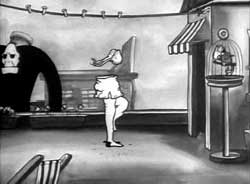 "Bimbo's Experimental Laboratory" sounds rather ominous, as Betty Boop's Penthouse (1933). An ideal example of Betty's classic period, this is a daring marvel with startlingly content. Scratch the surface just a tiny bit, & one finds a lot of radical content.
"Bimbo's Experimental Laboratory" sounds rather ominous, as Betty Boop's Penthouse (1933). An ideal example of Betty's classic period, this is a daring marvel with startlingly content. Scratch the surface just a tiny bit, & one finds a lot of radical content.
It opens with a shot of the lab with its broken smokin' factory chimney & explosions within, from failed experiments by Koko & Bimbo.
Bimbo gives a concoction to a harmless kitten who momentarily gets a lion's head then a dragon's head then returns to normal & says, "Whew! That's good stuff!"
Without ever saying it more clearly, the "laboratory" run by Koko & Bimbo is actually a Prohibition Era secret brewery.
Koko tries the same brew & his body burns off into a skeleton, then restores itself, & he too says, "Whew! I'll say it's good."
A number of extremely original & amusing "lab work gags" follow, definitely not the standard gags seen again & again in cartoons of the era. Koko is busy with an eye-dropper (it creates five-gallon "drops") filling huge bottles one by one (again unsaid, but for delivery to speak easies). In one of the giant drops, Koko sees Betty Boop, but it's her reflection from the next rooftop in the city.
Soon the two rum distillers are oggling an eyefull of Betty atop the building next door, taking a shower under the spray of a garden hose.
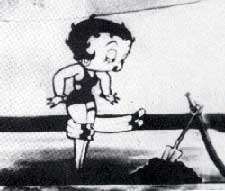 In a form-fitting bathing suit & her trademark garter belt & high heels Betty takes a nice long shower, then a self-animated towel dries her off as she giggles, "hee hee, ticklish" & gets felt-up from armpits to lower gams. In a form-fitting bathing suit & her trademark garter belt & high heels Betty takes a nice long shower, then a self-animated towel dries her off as she giggles, "hee hee, ticklish" & gets felt-up from armpits to lower gams.
With watering can she begins watering her lively tulip garden, as she sings a jazzy song with the oddest lyrics: "I'm here in my penthouse way up in the sky/ With hinges on chimneys for stars to go by/ Asleep like the heaven way up in the sky/ When I'm alone."
The second verse runs: "From all of society I'll stay aloof/ And live in propriety here on the roof/ A heavenly hermit I will be in truth/ When I'm alone."
Betty's song is "Penthouse Serenade" composed in 1931 by Will Jason & Val Burton. It's been covered by everyone from Nat King Cole to Sarah Vaughan to Bob Hope, Marianne Faithful, Liberace, Erroll Garner & scores of others.
But the lyrics as Betty sings them are quite different, as the original runs "When we're alone" for it is about lovers in their rooftop apartment, whereas Betty makes it really about withdrawing from the world & becoming a hermit.
While Koko & Bimbo watch Betty adoringly, the cat is busy mixing chemicals & heating them up, a bunson flame lighting its own cigar.
The cat's concoction distills into a tarry glob that springs up as a skull-faced hunchbacked monster that beats up Koko & Bimbo then goes after Betty.
While its making its way to Betty's rooftop, her dainties hanging on the line leap into a Betty shaped set of stockings & undies in order run off. Her parrot flies away inside its cage. The daisies jump out of their skin leaving frightened daisy-skeletons in the planting box, all to a hot jazz beat.
When the monster grabs Betty, she screams, but then spritzes him with perfume, & it all ends on a queer joke. The monster starts dancing a fairy-footed ballet for her while the birdy sings. He literally turns into a giant pansy, & Betty says, "Hee hee, you're such a nutsy dopesy!"
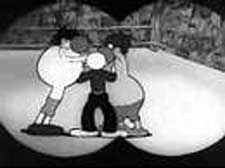 Betty works in a penny arcade in Admission Free (1932). She starts off with a barker's song that begins: "Change! Come get your pennies! Change! Your ten & twenties!" It's jazzy enough to be good fun.
Betty works in a penny arcade in Admission Free (1932). She starts off with a barker's song that begins: "Change! Come get your pennies! Change! Your ten & twenties!" It's jazzy enough to be good fun.
Koko the Clown changes a nickle for five pennies while she's singing. She gives him Indian-head pennies & they momentarily roll around in a circle like Indians dancing in a western movie. Bimbo gets change while making tongue-lolling googoo eyes at pretty Betty, then puts a penny in a kinetoscope so he can watch "Sahara Sadie."
Several minor gags follow as sundry patrons watch hand-cranked mini-films for a penny each or operate various sorts of penny-operated devices (the bit of kinetoscope film showing a boxing match reflects a historical reality, for which, see the page on Early Boxing Films).
Bimbo tries a shooting gallery. One of the tin rabbits turns out to be a real rabbit, & it jumps through a window to escape, so Bimbo in hunting cap heads off into the woods to hunt the rabbit. There's a minimum of woodland gags, involving squirrels trying to break open nuts & the rabbit setting off fireworks beside Bimbo.
For climax Betty & Bimbo are riding into the sky on one of the rabbit's fireworks rockets, though Betty was nowhere around the fireworks.
Why the last part of the cartoon has nothing whatsoever to do with the penny arcade is just the result of Max Fleischer's unwillingness to pay for a scriptwriter so the hired cartoonists just made stuff up on their own. It's a fun little cartoon in spite of itself.
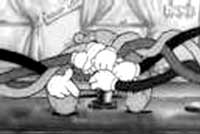 In Betty Boop's Bizzy Bee (1932), Betty's a pancake cook in a lunch wagon made from a recycled diner car. The story itself is somehwat a recycle, from Betty's debut in Dizzy Dishes (1930), but at that time Bimbo was the primary star & he owned the diner.
In Betty Boop's Bizzy Bee (1932), Betty's a pancake cook in a lunch wagon made from a recycled diner car. The story itself is somehwat a recycle, from Betty's debut in Dizzy Dishes (1930), but at that time Bimbo was the primary star & he owned the diner.
Her flapjacks do a hillbilly dance on the griddle. Bimbo comes a-courtin' bringing Betty what he calls a rose (it's a daisy). Her heart flies away from her & Bimbo chases after it with a net. Betty catches it herself & tucks back in her blouse.
Koko's at the counter & orders hot soup. It's cold, however, with flies skating around on the hard surface. Betty apologizes & sets the greasy surface on fire for him. The various animal patrons sing a demanding song "Pass Me the Sugar."
The oddest bit in this film is the miniature Bimbo who apparently lives inside Betty's cook's hat. We see the miniature Bimbo, distinct from the Bimbo who brought the "rose," climbing on the edge of a bowl to crack eggs & use a beater on the batter.
The wheat cakes are flying fast & furious & a number of minor gags surround the feasting. Some of the cakes "get loose" & fly out of the lunch wagon & up to the moon. For climax everyone has eaten so many pancakes they get sick, even the moon; that, or Betty poisoned them.
It's a funny little episode but in many ways most resembles post-Code episodes which so often reduced Betty to a cook rather than a sexy entertainer (though here at least she seems to be the restaurant owner rather than employee). Most of the gags were already tired ones. The title is meaningless, too. Betty is busy making griddle cakes, but where's the bee?
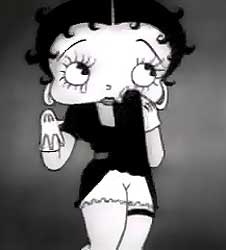 I Betty Boop's Museum (1932), Koko the Clown runs a sight-seeing bus, which alas no one is interested in taking. Finally Betty Boop gets on the tour bus. I Betty Boop's Museum (1932), Koko the Clown runs a sight-seeing bus, which alas no one is interested in taking. Finally Betty Boop gets on the tour bus.
Since she's the only rider, Koko drives his tiny sports car out of the false shell of a bus. There are several minor gags getting Betty to the point of arrival at the Museum.
The title's misleading, as it's not Betty's museum. Bimbo works there as curator & guide. A handful of novel but not all that funny gags proceed as Betty checks out the odd exhibits, then the Museum closes, accidentally locking Betty in.
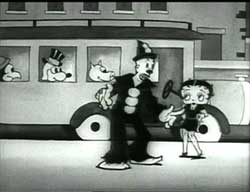 The night's much more interesting than the daytime in the spooky place. Skeletons play games with their bones. The night's much more interesting than the daytime in the spooky place. Skeletons play games with their bones.
The statue of Pan dances & plays & mice follow him about like he's the Pied Piper. A frightful horned skeleton grabs Betty through a wall & demands she sing for the gathering of bones.
She sings, "I never thought that anyone in their right mind/ Could ever treat another human so unkind/ Didn't you kidnap me & leave my friends behind/ Is that the human thing to do?"
Creepy exhibits have all sprung to life & are dancig about. There follows a generic chase scene culminating in a statue of Samson knocking over the museum pillars, Bimbo arriving in a horse-drawn chariot to get Betty out before the whole building collapses.
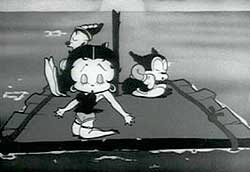 S.O.S.; aka, Swim or Sink (1932) is very minor Betty really. It begins with sailory voices singing gruffly, "What shall we do with a drunken sailor."
S.O.S.; aka, Swim or Sink (1932) is very minor Betty really. It begins with sailory voices singing gruffly, "What shall we do with a drunken sailor."
A ship is shown on rough seas in a storm, going down. Various animals are soon swimming around in the stormy seas. It appears that there were only three survivors, Koko the Clown, Bimbo the Dog, & Betty Boop.
On their raft after the storm, Betty sings "Oh momma, what can we do." They're "saved" by a pirate ship. Animal pirates hold them captive at point of cutlass.
The giant pegleg cat-captain wants Betty for his companion, while Koko & Bimbo are chained in the depths of the hold. They soon escape, fetch Betty, & they run around & around the deck, somehow tricking the pirates into falling off the boat to be swallowed by a whale, wherein they continue to drink & sing.
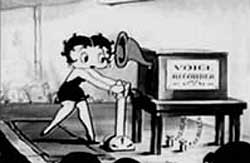 Betty participates in "The Big Invention Show" as musical accompaniest & inventor in Betty Boop's Crazy Inventions (1932). Bimbo sells ten cent tickets & Koko tears the tickets at the entrance of the bigtop.
Betty participates in "The Big Invention Show" as musical accompaniest & inventor in Betty Boop's Crazy Inventions (1932). Bimbo sells ten cent tickets & Koko tears the tickets at the entrance of the bigtop.
The spot remover machine which Betty exhibits cuts holes in material wherever there's a stain. Bimbo shows how the cigarette snuffer machine works. A chicken operates the automatic egg cracking device.
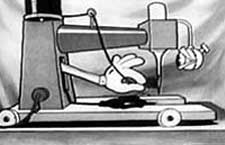 Koko the Clown has adapted a typewriter as a device for eating corn on the cob. Betty gets someone from the audience to show how the soup silencer works for people who slurp their soup. Koko the Clown has adapted a typewriter as a device for eating corn on the cob. Betty gets someone from the audience to show how the soup silencer works for people who slurp their soup.
Betty records one of her best known songs, "Keep a Little Song Handy," in the mouse-operated voice recorder. When it plays back, it's actually the mouse singing & not Betty's voice at all.
Koko's self-threading sewing machine snatches off Koko's clothing then goes on a rampage sewing things shut including a hippo's big mouth & the entire big top then a ditch outside & an entire river. All very cute.
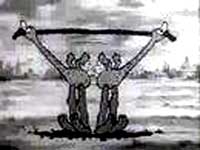 Betty Boop's May Party (1933) finds our party gal on a riverboat celebration, crowned the May Queen. They arrive at a dock & hundreds of revellers flood down the plank, along the dock, & out into the street. Soon Betty is leading a May Day parade with Bimbo the dog crowned king at her side, & mice carrying Betty's long cape/train.
Betty Boop's May Party (1933) finds our party gal on a riverboat celebration, crowned the May Queen. They arrive at a dock & hundreds of revellers flood down the plank, along the dock, & out into the street. Soon Betty is leading a May Day parade with Bimbo the dog crowned king at her side, & mice carrying Betty's long cape/train.
The May Day parade is quite an exciting piece of animation with lots of little gags imbedded in amidst wonderful animal characters.
When Betty's placed before the May Queen's seat at parade's end, she remains standing to sing "Here We Are" by Harry Warren (perhaps best remembered for the tune to "Lullaby of Broadway") & Gus Kahn (who composed such gigantic ragtime era hits as "Toot Toot Tootsie" & "Yes Sir, That's My Baby"). The lyric goes in part: "Here we are, you & I/ Like the world, hurried by/ Let me give you kids an ear full/ Go on & be cheerful/ Cuz here we are."
Everyone hurries on to the carnival rides for another set of gags. By now we're only at the halfway mark of the film, which is just crammed with events, though void of any particular story.
Betty dances with an elephant who then begins to play its trunk like a bassoon. He then gets his trunks stuck in a rubber tree & when he pulls them out, everyone is sprayed with rubber sap, making for some stretchy rubbery gags in this ultra gag-fest.
Even the river has been rubberized & divers off the pier find themselves on a trampoline. Bimbo & Koko make a guest appearance as stretching & wobbling dancers. Betty, Koko & Bimbo bounce around on the street, then everyone loads back in the riverboat & bounces back up stream.
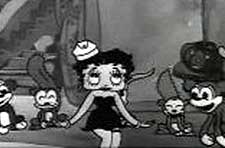 Betty Boop often got in supernatural scrapes of terror, so what better subject than a Halloween Party (1933). Across the landscape are numerous ghostly presences. Betty Boop often got in supernatural scrapes of terror, so what better subject than a Halloween Party (1933). Across the landscape are numerous ghostly presences.
The temperature has dropped to freezing & the scarecrow has to find a thicker coat to wear. An invitation to a dinner party at Betty Boop's house flutters by in the wind & the scarecrow grabs it, figuring he'll go get warm.
"Hello Scary!" Betty cries happily. "Come on in!" Scary the Scarecrow sits down by the fire but his straw accidentally catches fire & he has to dunk himself in a bucket of water.
In the kitchen the kitten is helping Betty prepare pumpkins. Scary begins to decorate the living room with Halloween symbols.
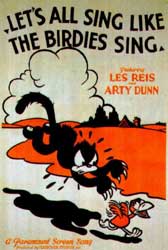 Guests arrive at last, mostly enormous mice but a few other animals, including a smallish elephant. Betty sings "Lets all Sing like the Birdies Sing, Tweet, Tweet, Tweet" with tune by Tolchard Evans & H. Tilsey, words by Robert Hargreaves and Stanley J. Damerell. Guests arrive at last, mostly enormous mice but a few other animals, including a smallish elephant. Betty sings "Lets all Sing like the Birdies Sing, Tweet, Tweet, Tweet" with tune by Tolchard Evans & H. Tilsey, words by Robert Hargreaves and Stanley J. Damerell.
It's not one of her jazzier numbers, but it's cute, & it was one of the more popular vaudeville songs of the 1930s. A year after the Fleischer Brothers had Betty sing it, they released a non-Boop cartoon called Let's All Sing like the Birdies Sing (1934), a lively animals cartoon featuring the vocal talents of Artie Dunn & Les Reis.
Various autumn party events proceed, suprisingly with far less spookiness than in many of Betty's non-halloween films.
A party crasher is on the way, however, a rather angry gorilla who drinks up all the cider & threatens Betty. Only then do ghosts & demons appear, manifesting from Scary's halloween designs painted on the wall, to take care of tha mean old gorilla saving Betty & her party-goers. A fun film in a minor note.
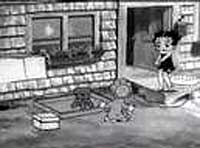 Betty Boop's Birthday Party (1933) starts out with no party at all. She sings a blues number "I Got Nobody to Hear My Song (So I'm Hummin' to Myself"), a piece by Herbert Magidson, Monte Siegal & Sammy Fain which had been a big hit the year before for Connie Boswell (much more recently Linda Rondstadt covered it).
Betty Boop's Birthday Party (1933) starts out with no party at all. She sings a blues number "I Got Nobody to Hear My Song (So I'm Hummin' to Myself"), a piece by Herbert Magidson, Monte Siegal & Sammy Fain which had been a big hit the year before for Connie Boswell (much more recently Linda Rondstadt covered it).
As Betty sings, she scrubs the floors on hands & knees, washes dishes, laundry, & so on. Possibly she's a housemaid since there's so darned much stuff accumulated, though it otherwise looks like it's her house & it's a year's pile-up of undone work.
Someone anonymously leaves a birthday cake at the door. If you can trust the number of candles, busy Betty is only fifteen years old. Turns out the cake is from Bimbo, Koko, & all Betty's animal buddies, who're putting on a surprise party for her at her house.
Koko the Clown gives her a weiner dog with a reeeeeeeeeealy long weiner body for a present. Bimbo gives her a bowl of talking fish. The baby Alyosius gives her a piano from a tiny box, which she begins playing an original number apparently called "This is Betty's Birthday Party Day."
A big feast appears with a lot of standard big feast gags. Then a brawl breaks out with lots of stuff tossed or broken, with a lot of fighting gags. Betty tries to get them to stop fighting, so she gets on a fountain statue of Washington Crossing the Delaware & the characters come alive & row her away from the trouble.
Despite a fine opening song, this is not the equal of most episodes of the year, unbelievably released immediately after one of the best, Snow White (1933). And unless she's left home forever, she's going to have even more drudge work to repair when it's all over.
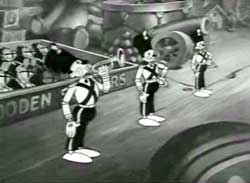 But by gum, here's a great one, Parade of the Wooden Soldiers (1933).
But by gum, here's a great one, Parade of the Wooden Soldiers (1933).
Even though it's aimed younger than most of the Classique Years Boops, it's just so darned imaginative & fun, with Betty as her own action figure.
It opens with footage of David Rubinoff & his Orchestra who'll provide the musical soundtrack to this episode.
As the animation begins we're introduced to a run-down toy factory, then see an airplane drop a bundle down the chimney of a distant toy shop.
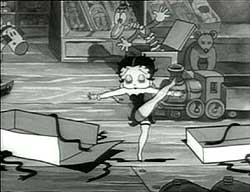 The contents of the package turns out to be Betty Boop, apparently a merchandising doll. The contents of the package turns out to be Betty Boop, apparently a merchandising doll.
All the wooden soldiers spring to life to greet her. The March of the Wooden Soldiers, together with all sorts of other toys, proceeds.
Betty sings "I'm Glad I'm Here" between instrumental renditions of the March. A throne is made for her out of letter blocks.
The great joy of the celebration is spoilt when a bargain rag doll gorilla gets mad & starts wrecking the place. He'd been in the bargain bin as a bad toy.
The ape gets it in his head to rip off Betty's head & put it on another doll. He kidnaps Betty King Kong style & puts her in Perils of Pauline situations, while wooden soldiers & toy airplanes attack him. When he's good & tied up, the March continues on with Betty leading. Wadda cartoon, lemme tellya.
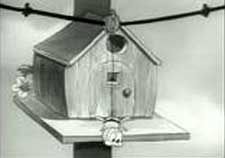 We'll again meet up with David Rubinoff & His Orchestra in the live-action opening of Morning Noon & Night (1933), Rubinoff playing a lovely violin piece quite at odds with Betty Boop's style of jazz.
We'll again meet up with David Rubinoff & His Orchestra in the live-action opening of Morning Noon & Night (1933), Rubinoff playing a lovely violin piece quite at odds with Betty Boop's style of jazz.
It segways into a sequence set in the morning dawn as the sun rises, the chickens awaken, the flowers open, with a milk-delivering bird having a clarinet for a beak. A baby bird practicing flight falls to the ground where it is assisted by flowers & its mom. At last Betty appears from her country cottage to feed the chickens outside her door.
The bullying members of the Tom Kats Social Club show up in a jaloppy, drunk & ready to molest the birds near Betty's cottage. The barnyard fowl assisted by Betty take on the bullying cats, but they're getting the upper hand chopping down trees & kidnapping Betty, forcing her to party against her will.
A boxing rooster decides to take them on, freeing Betty. Other birds drop a bee's nest on the cats. Betty is the rooster's boxing coach. By nightfall the cats have been defeated.
Betty's personality & individuality really never comes into play & she might as well have been just about any character, but it's a pleasant enough cartoon.
copyright © by Paghat the Ratgirl
|
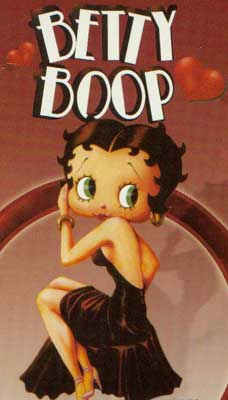

 In a form-fitting bathing suit & her trademark garter belt & high heels Betty takes a nice long shower, then a self-animated towel dries her off as she giggles, "hee hee, ticklish" & gets felt-up from armpits to lower gams.
In a form-fitting bathing suit & her trademark garter belt & high heels Betty takes a nice long shower, then a self-animated towel dries her off as she giggles, "hee hee, ticklish" & gets felt-up from armpits to lower gams.


 The night's much more interesting than the daytime in the spooky place. Skeletons play games with their bones.
The night's much more interesting than the daytime in the spooky place. Skeletons play games with their bones.

 Koko the Clown has adapted a typewriter as a device for eating corn on the cob. Betty gets someone from the audience to show how the soup silencer works for people who slurp their soup.
Koko the Clown has adapted a typewriter as a device for eating corn on the cob. Betty gets someone from the audience to show how the soup silencer works for people who slurp their soup.

 Guests arrive at last, mostly enormous mice but a few other animals, including a smallish elephant. Betty sings "Lets all Sing like the Birdies Sing, Tweet, Tweet, Tweet" with tune by Tolchard Evans & H. Tilsey, words by Robert Hargreaves and Stanley J. Damerell.
Guests arrive at last, mostly enormous mice but a few other animals, including a smallish elephant. Betty sings "Lets all Sing like the Birdies Sing, Tweet, Tweet, Tweet" with tune by Tolchard Evans & H. Tilsey, words by Robert Hargreaves and Stanley J. Damerell.

 The contents of the package turns out to be Betty Boop, apparently a merchandising doll.
The contents of the package turns out to be Betty Boop, apparently a merchandising doll.